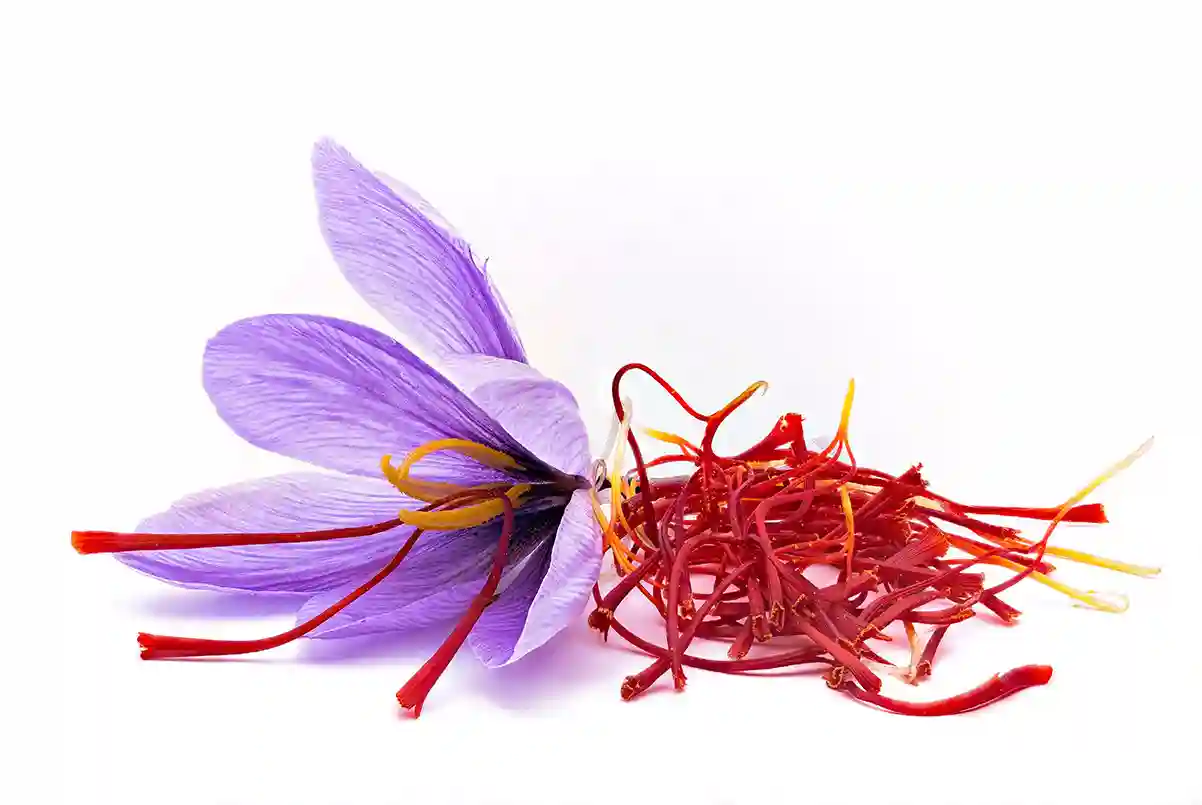What is saffron?
Learn more about saffron and discover the many beneficial uses of this spice. Obtained from the Crocus sativus Linnaeus, saffron has been utilized for various purposes for more than 4,000 years. We're delighted to share insights into this herb's history and current practical applications. Are you intrigued? Then keep reading for additional details.
Where does it come from?
 Saffron is extracted from the Crocus sativus, a perennial flower bulb species that sprouts from a spherical tuber. The Crocus sativus blooms in autumn and reproduces only through its tubers and not by seed. The flower, also called saffron flower, of this bulbous plant contains three stigmas that eventually form the saffron when dried. After drying and ripening, the saffron threads can be used for medical, flavor enhancement and pigmentation purposes.
Saffron is extracted from the Crocus sativus, a perennial flower bulb species that sprouts from a spherical tuber. The Crocus sativus blooms in autumn and reproduces only through its tubers and not by seed. The flower, also called saffron flower, of this bulbous plant contains three stigmas that eventually form the saffron when dried. After drying and ripening, the saffron threads can be used for medical, flavor enhancement and pigmentation purposes.
The saffron crocus does not occur in the wild, but is cultivated for its saffron in a large number of countries around the world. Iran is by far the largest producer of saffron, but the saffron flowers are also grown on a large scale in countries such as India, Afghanistan, China, Spain and some countries around the Mediterranean Sea.
In recent decades, we at Bloembollenbedrijf J.C.Koot have specialized in the optimal cultivation of the Crocus sativus. Thanks to this specialization, we can supply Crocus sativus bulbs that produce a lot of saffron flowers and we have now grown into the most important wholesaler in the Netherlands and beyond.
The most expensive spice in the world
If you're curious about the world's priciest flavoring, we can tell you with certainty that it is saffron. But why is saffron so expensive? TThe reason for its exorbitant cost lies in the demanding process required to produce even a small quantity. For each kilogram of saffron, 150,000 to 200,000 flowers of the Crocus sativus are needed, which must be carefully harvested by hand. Given the considerable manual labor and the quantity of crocus bulbs required, saffron is often regarded as the most expensive flavoring globally, hence earning the nickname "red gold".
Its use
Saffron in the kitchen
As you have read in the introduction of this text, there are various applications in which you can use saffron. To this day, we see that this spice is still regularly used in the kitchen to give dishes extra flavor and, above all, color. The taste of saffron is best described as honeyed with earthy influences with an aftertaste that can be called slightly bitter. Due to the natural color properties of saffron, it is ideal for giving rice dishes such as paella and risotto a nice yellow color. Mainly because of its taste, it is used, for example, in some Arab countries to give coffee and tea extra flavor. It is therefore highly recommended to experience the taste and color of this spice yourself and to incorporate it into your dishes according to your own preference.
Saffron health benefits
Saffron has been used for medicinal purposes for thousands of years, in addition to its use in cooking. Its popularity as a medicinal herb precedes its culinary use. Saffron is associated with numerous health benefits, some of which include:
- A natural antidepressant;
- A calming effect;
- Strengthening the respiratory system, immune system, cardiovascular system, nervous system and reproductive system;
- The carotenoids present help slow down macular degeneration.
In addition to the above health benefits of saffron, it can also be used to relieve pain such as toothache, headache, stomach cramps and various other complaints. Several studies have also been conducted that have shown that this condiment can have a positive impact on weight loss because it suppresses the feeling of hunger.
Saffron benefits in other applications
In addition to the above purposes, saffron can also be used in other ways. For example, saffron dye can be used to dye garments or other items. In addition, saffron powder can be mixed with cream to make the skin smoother and more radiant. In history, this herb was often mixed with milk and sandalwood, among other things, to make face masks. Nowadays there are even many health products for sale, such as nutritional saffron supplements, creams and masks containing saffron.
Points to consider while buying saffron
Due to the high price of saffron, it is unfortunately susceptible to fraud and this is precisely the reason why it is always important to keep a few things in mind. For example, if this herb is offered at a bargain price, you can usually assume that this is not an authentic herb. It is also always important to check with the supplier where the saffron was produced. You can also often see and feel from the product itself whether you are dealing with authentic or counterfeit. For example, always check that the saffron threads are not too dry or are sticky and that all threads have the same shape. More tips on buying this condiment can be found on our page on what to look out for when buying saffron.
This was just a brief summary of what saffron is and what it can be used for. Clicking on the images below will take you to the pages where we go deeper into the various topics discussed above.






















 BIO bulbs
BIO bulbs
 NON-BIO bulbs
NON-BIO bulbs
 Wholesale
Wholesale
 Miscellaneous flower bulbs
Miscellaneous flower bulbs









